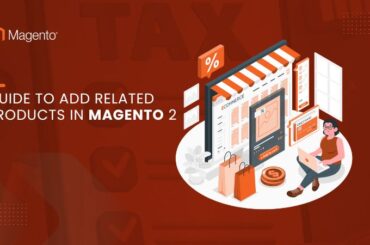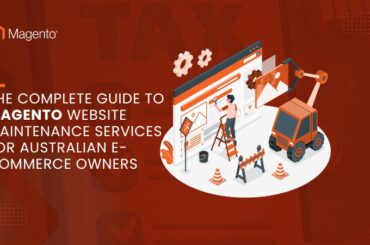Magento Online Store: How to Convert a Magento Store to Mobile App?
Last Updated | July 27, 2023
Table of Contents
Getting on the eCommerce bandwagon is a no-brainer for any business looking to maximize its reach and sales, and Magento is definitely one of the best platforms to start your eCommerce journey. Now, here we won’t be comparing Magento with other platforms or discussing the benefits of Magento for eCommerce stores. Rather, in this blog, we will exclusively be looking at why you should convert your Magento online store into a mobile app.
Just like a decade ago, eCommerce was the big bubble that everyone was looking to get a pie of, in today’s mobile-oriented world, being online isn’t sufficient to reach the maximum audience, rather you need to get deeper into the pockets and fingertips of your audience. Obviously, today it’s all about businesses developing mobile apps to not only be more accessible to customers but also to gather more data about client’s preferences and improve their chances for conversion optimization.
Now just to give you an example, the estimated revenue generation by mobile apps across the world is expected to pass USD 200 billion by the year 2021, now, this is a massive number we are talking about, right? This includes the revenues generated through app stores and in-app advertising.
Ok, so a more pressing question is that if you want to become claim your share of this massive market, or are you happy just to be left out? You definitely don’t want to miss out on this opportunity, so perhaps it’s time to get a mobile app for your Magento online store.
But wait, building a mobile application for Magento’s online store isn’t that simple. You need to take on board a professional Magento B2B development company that got the experience and resources to develop an interactive and highly functional Magento online store mobile app for you. Well, whatever route you choose for Magento development services, below we will be looking at some recommended methods to convert your Magento online store into a functional and lively mobile app.
Let’s dive in…
Contemplating the Options
So, once you have decided to develop a mobile app for your Magento store, there are two definite ways to go. The first one is to hire a professional Magento development services agency that can get the job done for you. This is a simple and efficient method of developing a mobile app for Magento online stores, however, the downside here is the higher cost of development.
Now, as part of the procedure, you will have one on one meeting with the development team, to whom you will explain the scope of the project, including the design aspirations, objectives, target market, product line, target audience, and other important elements. From there on, the development team will take over to create an intuitive, and interactive mobile app for your Magento store.
However, this isn’t the only method…
In fact, the second approach is even simpler and functional and that’s about Magento mobile app integration extensions. To help businesses fasten the process of mobile app development many companies have pre-built Magento extensions. These are specialized mobile app builders which can easily access data from the Magento website to integrate it into the mobile app. Folio3 offers comprehensive Magento mobile app builder connectors and Magento to Shopify Migration connectors which are meant to offer Magento online stores an easy and streamlined approach to convert their stores into mobile apps or migrate from Magento platform to Shopify.
Ok, as mentioned above this method is preferred because of its efficient and streamlined procedure to create an eCommerce application. It’s just like integrating an extension to the website, and if you feel like having some custom functionality, it can always be added through the framework developer.
So, you can decide on any of the models described above depending upon your preference and website structure.
Building the UI
Once you have finalized the development model, the next important aspect to consider is the interface and design of the mobile app. Remember, in today’s world design application and interface could make or break the user experience, and thus it’s important for you to have a highly functional and intuitive interface for your Magento store mobile app.
Starting from the home page, the app needs to awe-inspire the users and attract them to explore your offerings and promotions. Also, you need to keep the design minimalist to not clutter the elements, which can actually bring down the user experience. Not to forget about the navigation of the website. Users must be able to find any of the desired products/services with few clicks, without having to browse through the entire site.
Overall, the key is to have an intuitive interface with a minimalist, yet the captivating design and simple navigation to offer the best user interface to customers.
Checkout Process
No one likes to fill out long forms, and complicated queries, right? I mean eCommerce shouldn’t be like filling out forms for bank loans. So, better keep your Magento eCommerce store mobile app away from such things.
According to stats, over 90% of customers prefer to shop online with stores or applications that offer a single-step checkout process. Besides, the whole purpose of developing a mobile app is to already have the customers’ relevant data feed into the system, which can be used to optimized the marketing, and checkout process. The best practice in this regard is to have them log in with their social media or Google account.
This way you will be able to extract all relevant information beforehand and offer a streamlined and efficient checkout process. This will also greatly improve conversion rates for the app since customers will go through the entire process in a single go.
Well, the above-mentioned are definitely the most pressing aspects. However, these aren’t the only aspect to consider, rather there are various other little yet important aspects that you need to consider to successfully pull out a mobile app for Magento online store including;
- Since over 80% of mobile users are right-handed, the design of the app should be right-thumb friendly for optimized user experience
- Make sure that the app is updated with the latest Magento version
- Make sure to add robust security protocols for the app. Even a single security breach can utterly shatter the reputation of your store, leaving you hanging in the middle of nowhere.
- Only choose a reliable and trusted Magento development services agency that got the experience, expertise, and skills to create a user-friendly, and functional mobile app
How to set up a Magento Online Store?
Now that we are done with top tips to develop a mobile app for Magento online store, let’s now briefly explore the method of setting up a Magento online store. While we strongly recommend hiring a professional Magento development services agency (since Magento is a complex platform relative to Shopify, WordPress, or other platforms), these steps can help you get started in setting up an online store;
Sign up to Magento Go
For starters, simply head over to the Magento website. It’s a massive platform where you will have tons of interesting stuff to see including in-depth tutorials, company details, success stories, and others. Don’t worry if most of the stuff goes over your head since most of the stuff is meant for developers.
As a non-techie businessman, you can rather head over to the Magento showcase. Here you will find plenty of inspirational stuff like leading brands powered by Magento. You can visit these sites to get a feel for your store, as well.
You can also check out Envato Elements and other such platforms which have thousands of Magento themes and templates, ready to purchase to get started with your Magento store.
Nonetheless, once you have gone through the site just get registered and follow the steps below;
Name Your Store
Next, you need to pick a name for your store. Now, until you are buying a domain, you don’t need to stress a lot about naming the store, since it can be changed at any time. You can always think of another suitable name at the later stages.
Fill Out Your Business Details
Next, you will be required to submit the business details including the name, location, phone number, username, and password. You may also submit experience level and industry, where required.
For security purposes, the password must be at least eight characters long, and be case sensitive, as well as, should include a special character(s).
Once you are done filling the form, simply click “create my store”.
Clicking “create my store” means you agree to Magento Go’s terms of service, which otherwise you can read by clicking at the “Terms of Service” tab located at the bottom of the Home Page.
Head Over to Store Admin
After submission of the form, you will receive a confirmation email with a link to your store admin page. Once you got the email, simply click through the link to access the admin page and start customizing the store.
Well, congratulations, you have successfully set up the Magento store. Now, you can choose all the details like design templates, add products, integrate a shopping cart, set checkout procedure, and other stuff to get started!
FAQs:
What is the cost of Magento eCommerce online store in the US?
Average cost – $20,000 to $40,000.
Magento is a powerful and highly preferred platform for eCommerce stores. Unfortunately, it doesn’t offer interactive development features like Shopify, or other platforms. Thereby, you would need professional Magento development services in the US. Now, the final cost of a Magento eCommerce online store in the US will depend on the size, complexity, customization and other features, on average a basic Magento 2 eCommerce store may set you back anywhere from $20,000 to $40,000.
What is the Cost of Mobile App in the US?
Basic mobile app average cost in the US: $90,000
The cost of a mobile app varies significantly with respect to the size, functionalities, customization, and other aspects. A high-end complex mobile application may cost as much as $250,000+ in the US market, whereas, a basic mobile application in the US may cost up to $90,000. However, you can also choose a pay-per-hour model, where the average price of an experienced mobile app developer may range from $40 per hour to $100 per hour; depending on the skills, experience, and customization requirement for the app.
Is Magento cheaper than Shopify?
Since Magento is an open-source platform many people think it’s cheaper as compared to Shopify. However, the actual price of the Magento online store will depend on the development costs including the customization and features required. This means that Magento stores may cost from hundreds of dollars to hundreds of thousands of dollars.
Alternatively, Shopify offers three flat-rate pricing plans for store development. Now, while on the surface, these may seem cheaper as compared to Magento development cost, however, the cost of apps, and themes has to be added to get a final price of a Shopify store.
Is Magento good for small businesses?
Open Source platforms are ideal for SMEs with a limited budget. Magento like many other open-source platforms offers small businesses an affordable opportunity to create a high-performance eCommerce store. Since Magento is specifically meant to be a platform for an eCommerce store, it also brings in a lot of functionalities, and customization options to create a fully functional and high-performing eCommerce store.
Which is better Magento or WordPress for eCommerce?
Magento is better if you are looking to create a large eCommerce store with lots of functionalities and features. WordPress, on the other hand, is a better option for small businesses with a limited budget looking to set up a small or medium store with no more than a hundred products.
What is the difference between Magento and WordPress?
WordPress and Magento both are powerful, and widely used web development platforms. While the two platforms share incredible similarities, there are subtle differences between the two as well. For instance, Magento is highly preferred and performs exceptionally better for eCommerce stores with its powerful features, and customization options. WordPress on the other hand is a highly preferred platform that is known for its robust market features and custom












